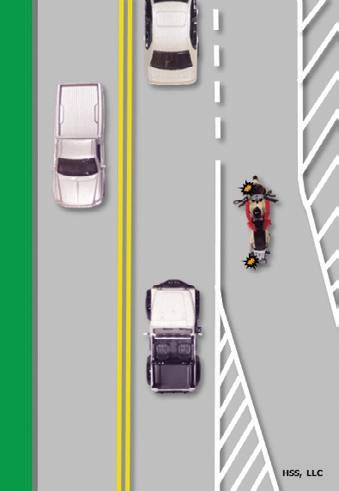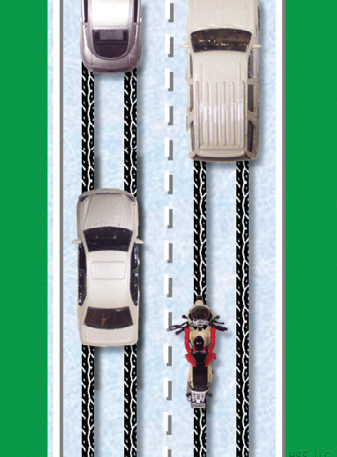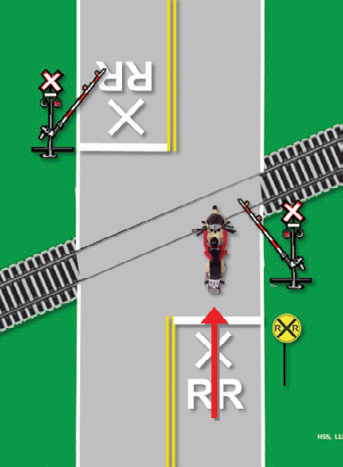
Section 5.6 - 5.7
5.6 – Increasing Conspicuity
In crashes with motorcyclists, drivers often say that they never saw the motorcycle. From ahead or behind, a motorcycle’s outline is much smaller than a car’s. Also, it’s hard to see something you are not looking for, and most drivers are not looking for motorcycles. More likely, they are looking through the narrow, two-wheeled silhouette in search of cars that may pose a problem to them.
Even if a driver does see you coming, you aren’t necessarily safe. Motorcycles may appear farther away, and seem to be traveling slower than they actually are. It is common for drivers to pull out in front of motorcyclists, thinking they have plenty of time. Too often, they are wrong. However, you can do many things to make it easier for others to recognize you and your cycle.
Clothing

Most crashes occur in broad daylight. Wear bright colored clothing to increase your chances of being seen. Remember, your body is half of the visible surface area of the rider-motorcycle unit.
Reflective, bright colored clothing is best. Bright orange, red, yellow or green jackets or vests are your best bets for being seen. Brightly colored helmets can also help others see you. Reflective material on a vest and on the sides of the helmet will help drivers coming from the side spot you. Reflective material can also be a big help for drivers coming toward you or from behind.
Headlight
The best way to help others see your motorcycle is to keep the headlight on – at all times.
(NOTE: New motorcycles sold in the USA since 1978 automatically have the headlights on when running.) Studies show that, during the day, a motorcycle with its light on is twice as likely to be noticed. Also, use your low beams in fog or at night when traffic approaches.
Signals

The signals on a motorcycle are the same as those on a car. They tell others what you plan to do. Use them anytime you plan to change lanes or turn. Use them even when you think no one else is around. Due to a rider’s added vulnerability, signals are even more important. They make you easier to spot.
When you enter a freeway, drivers approaching from behind are more likely to see your signal blinking and make room for you.
Once you turn, make sure your signal is off or a driver may pull directly into your path, thinking you plan to turn again.
Brake Light
Your motorcycle’s brake light is usually not as noticeable as the brake lights on a car – particularly when your taillight is on. (The taillight goes on with the headlight.) If the situation will permit, help others notice you by flashing your brake light before you slow down.
It is especially important to flash your brake light before:
- You slow when others might not expect (for example, turning off a high-speed highway.)
- You slow where others may not expect it (for example, in the middle of a block or at an alley.)
If you are being followed closely, it’s a good idea to flash your brake light before you slow down. The tailgater may be watching you and not see something ahead that will make you slow down. This will hopefully discourage them from tailgating and warn them of hazards ahead they may not see.
Horn
Be ready to use your horn to get someone’s attention quickly. Keep in mind that a motorcycle’s horn isn’t as loud as a car’s, therefore, use it, but don’t rely on it. Other strategies may be appropriate along with the horn.
5.7 – Speed Management
Handling Dangerous Surfaces
- Slippery surfaces
- Railroad tracks
- Grooves and gratings
Slippery Surfaces
On slippery surfaces, you should use added caution. Motorcycles handle better when ridden on surfaces with good traction. Maintaining balance and cycle control are difficult on slippery surfaces.
To reduce your risk, you can take certain preventative measures:
- Reduce Speed – Slow down before you get to a slippery surface to lessen your chances of skidding and increase your following distance. Your motorcycle needs more distance to stop. And, it is particularly important to reduce speed before entering wet curves.
- Avoid Sudden Moves – Any sudden changes in speed or direction can cause a skid. Be as smooth as possible when you speed up, shift gears, turn or brake.
- Use Both Brakes – The front brake is still effective, even on a slippery surface. Squeeze the brake lever gradually to avoid locking the front wheel. Remember, apply gentle pressure on the rear brake.

Surfaces that provide poor traction include:
- Wet surfaces – Particularly, just after it starts to rain and before surface oil washes to the side of the road. When it starts to rain, ride in the tire tracks left by cars and avoid pooled water and highway ruts. Often, the left tire track will be the best position, depending on traffic and other road conditions as well.
- Ice or snow covered surfaces – Snow melts faster on some sections of a road than on others. Patches of ice can occur in low or shaded areas and on bridges and overpasses. It is recommended you avoid snow and ice covered surfaces.
- Shiny surfaces – Metal covers, steel plates, bridge gratings, train tracks, lane markings, leaves and wood can be very treacherous when wet.
- Dirt and gravel – On curves and ramps leading to and from highways, dirt and gravel can collect along the sides of the road. Choose a lane position that minimizes the risk of injury.
- Oil spots – Watch for these when you put your foot down to stop or park. You may slip and fall. Securing the proper footing will help you from losing your balance or falling.
Railroad Tracks, Trolley Tracks and Pavement Seams
Crossing Tracks

Usually, it is safer to ride straight within your lane to cross tracks. Turning to take tracks at a 90 degree angle can be more dangerous – your path may carry you into another lane of traffic.
Crossing Parallel Tracks

For track and road seams that run parallel to your course, move far enough away from tracks, ruts, or pavement seams to cross at an angle of at least 45. Then, make a quick, sharp turn. Edging across could catch your tires and throw you off balance.